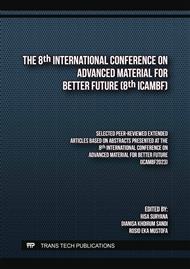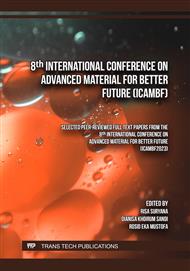[1]
M. A. Ahmed, H. A. Al-Kahtani, I. Jaswir, H. AbuTarboush, and E. A. Ismail, Extraction and characterization of gelatin from camel skin (potential halal gelatin) and production of gelatin nanoparticles, Saudi J Biol Sci, vol. 27, 6 (2020), p.1596–1601.
DOI: 10.1016/j.sjbs.2020.03.022
Google Scholar
[2]
M. Nurilmala, H. Suryamarevita, H. Husein Hizbullah, A. M. Jacoeb, and Y. Ochiai, Fish skin as a biomaterial for halal collagen and gelatin, Saudi Journal of Biological Sciences, vol. 29, no. 2. Elsevier B.V., (2022) p.1100–1110.
DOI: 10.1016/j.sjbs.2021.09.056
Google Scholar
[3]
A. da T. Alfaro, G. G. Fonseca, E. Balbinot, A. Machado, and C. Prentice, Physical and chemical properties of wami tilapia skin gelatin, Food Science and Technology, vol. 33, no. 3, (2013), p.592–595.
DOI: 10.1590/s0101-20612013005000069
Google Scholar
[4]
W. E. Triastuti, The Production of Gelatin from Snapper Scales (Lutjanus camphecanus Sp.) through Enzymatic Pretreatment, IPTEK The Journal of Engineering, vol. 8, 1 (2022), p.44.
DOI: 10.12962/j23378557.v8i1.a12860
Google Scholar
[5]
H. Faradiella, P. D. F. Ningsih, and W. E. Triastuti, The acid solvent experimental studies on gelatin producing by utilizing snapper fishes scales waste (Lutjanus camphecanus sp.), AIP Conference Proceedings, American Institute of Physics Inc., (2017).
DOI: 10.1063/1.4978115
Google Scholar
[6]
A. Jongjareonrak, S. Benjakul, W. Visessanguan, T. Nagai, and M. Tanaka, Isolation and characterisation of acid and pepsin-solubilised collagens from the skin of Brownstripe red snapper (Lutjanus vitta), Food Chem, vol. 93, 3 (2005), .p.475–484
DOI: 10.1016/j.foodchem.2004.10.026
Google Scholar
[7]
E. P. A Nasution, Z. A. Muchlisin, C. Yulvizar, P., Pengaruh Kombinasi Enzim Papain dan Enzim Bromelin Terhadap Pemanfaatan Pakan dan Pertumbuhan Ikan Nilem Ostheocillus vittatus Effect of Papain and Bromelin Enzymes on The Growth Performance and Feed Utilization of Java Barb Ostheocillus vittatus, Jurnal Ilmiah Mahasiswa Kelautan dan Perikanan Unsyiah, vol. 2, (2017), p.339–348.
DOI: 10.31941/penaakuatika.v22i2.3223
Google Scholar
[8]
W. E. Triastuti et al., 'Extraction and purification of bromelain enzyme from queen pineapple', in AIP Conference Proceedings, American Institute of Physics Inc., (2021).
Google Scholar
[9]
S. Susanti, H. Rizqiati, I. F. Lisandi, Nuryanto, and F. Arifan, Optimization of Bromelain Isolation from Honi Pineapple Crown, International Journal of Food Studies, vol. 11, 2 (2022), p.287–295
DOI: 10.7455/ijfs/11.2.2022.a3
Google Scholar
[10]
A. Imeson (role)edt, Thickening and gelling agents for food. London : Blackie, 1992.
Google Scholar
[11]
J. Gumilar and A. Pratama, Produksi Dan Karakteristik Gelatin Halal Berbahan Dasar Usus Ayam, Jurnal Teknologi Industri Pertanian, vol. 28, 1 (2018), p.75–81.
DOI: 10.24961/j.tek.ind.pert.2018.28.1.75
Google Scholar
[12]
Z.A. Nur Hanani, Y.H. Roos, and J.P. Kerry, Use and application of gelatin as potential biodegradable packaging materials for food products, Int J Biol Macromol, 71(2014), pp.94-102.
DOI: 10.1016/j.ijbiomac.2014.04.027
Google Scholar
[13]
R. Rahmawati and S. Nurjanah, Pengaruh Konsentrasi Enzim Papain Terhadap Mutu Gelatin Bubuk Dari Tulang Dan Cakar Ayam, 2020.
Google Scholar
[14]
N. Hamzah et al., Profil Indeks Pengembangan Ikatan-Silang Gelatin-Kitosan Swelling Index Profile of Cross-link Gelatin-Chitosan, 2019.
DOI: 10.24252/djps.v2i2.12147
Google Scholar
[15]
G. O. Olatunde, L. K. Arogundade, and O. I. Orija, Chemical, functional and pasting properties of banana and plantain starches modified by pre-gelatinization, oxidation and acetylation, Cogent Food Agric, vol. 3, 1 (2017).
DOI: 10.1080/23311932.2017.1283079
Google Scholar
[16]
A. Triasih, A. Fakultas, P. Dan, I. Kelautan, S. Ratulangi, and S. Utara, Gelatin Ikan: Sumber, Komposisi Kimia Dan Potensi Pemanfaatannya, 2013.
DOI: 10.35800/mthp.1.2.2013.4167
Google Scholar
[17]
F. Badii and N. K. Howell, Fish gelatin: Structure, gelling properties and interaction with egg albumen proteins, Food Hydrocoll, vol. 20, 5 (2006), , p.630–640.
DOI: 10.1016/j.foodhyd.2005.06.006
Google Scholar
[18]
N. N. Aisyah, Poultry as an Alternative Source of Gelatin, 2014.
Google Scholar
[19]
S. Hermanto, L. O. Sumarlin, and W. Fatimah, Differentiation of Bovine and Porcine Gelatin Based on Spectroscopic and Electrophoretic Analysis, 2013.
Google Scholar
[20]
S. Prati, E. Joseph, G. Sciutto, and R. Mazzeo, New advances in the application of FTIR microscopy and spectroscopy for the characterization of artistic materials, Acc Chem Res, vol. 43, 6 2010), p.792–801.
DOI: 10.1021/ar900274f
Google Scholar
[21]
I. Milovanovic and M. Hayes, Marine gelatine from rest raw materials, Applied Sciences (Switzerland), MDPI AG, vol. 8, 12 (2018).
DOI: 10.3390/app8122407
Google Scholar



